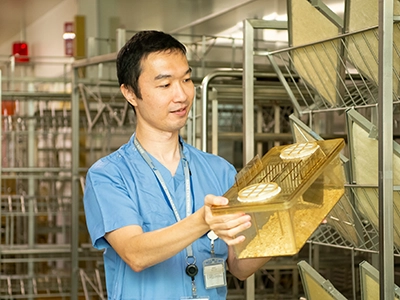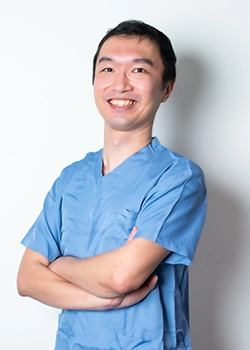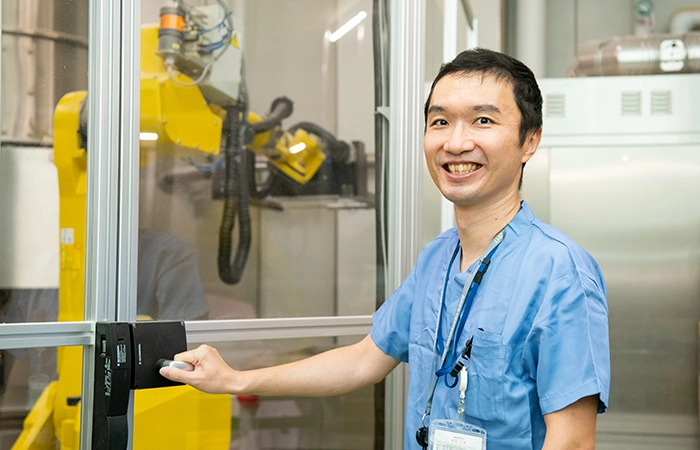Taking on New Challenges while Keeping an Eye on Needs that Change with the Times
BRC is supported by a diverse staff who are involved in a variety of tasks. We have interviewed staff members from each of the 12 laboratories that make up BRC, asking them about their activities and their day-to-day efforts in their research rooms.
This time, we are speaking with Shinya Ayabe, a Senior Research Scientist in the Experimental Animal Division.
We asked him about his role in supporting the creation of the new mouse resources he is currently working on, and about what he values in his job.
RIKEN BRC’s largest division
For the world’s highest level of quality control
The Experimental Animal Division collects, preserves, and controls the quality of internationally unique and state-of-the-art mouse models that meet social and research needs, and provides them to researchers both in Japan and abroad. In addition, the division develops and evaluates mouse strains needed by the research community and develops the technology necessary for the world’s highest level of quality control.
As a veterinarian, I am currently in charge of coordinating with recipient institutions when the division exports mouse resources, as well creating new mouse resources and developing the required technologies to accomplish this task. Moreover, I promote international collaboration as a member of an organization participating in the International Mouse Phenotyping Consortium (IMPC), as well as translating and disseminating overseas guidelines, promoting appropriate design of animal experiments, and improving the methodological rigor and reproducibility of animal experiments. In addition, as a generational change in the personnel in charge of the project is imminent, I have recently been making advance preparations in parallel with the above duties.
In this division, rather than multiple researchers working together on a single task, each individual works independently on their assigned work. But even though we work individually, this doesn’t mean that we cannot consult with each other, so for me it is a very comfortable workplace. I believe it is a well-established tradition at RIKEN BRC to allow each individual to maximize their strengths.
Creating new mouse resources by strengthening collaboration

As an international hub for mouse resources, the Experimental Animal Division handles state-of-the-art mouse models. In recent years, advances in experimental devices and technologies for analyzing human genetic information have accelerated, and as a mouse researcher, I believe there is an urgent need to develop new mouse models that are more useful for research than ever before and to increase the value of mice as a resource.
However, the development of new mouse resources cannot be carried out by this division alone. So, we are also collaborating with researchers in other divisions, such as Gene Engineering Division to confirm genetic manipulation, and the Mouse Phenotyping Analysis Division to determine the phenotype of the mice. On this campus, we have staff with various skills and specialties, and by working together we are finally creating a novel mouse resource.
I feel that this kind of cross-divisional collaboration to create a single product is in line with current trends around the world where needs are becoming increasingly fragmented as well as complex. In this sense, the times may have caught up with RIKEN BRC’s approach in which multiple divisions handling various resources are gathered in one place to conduct research and development. I heard that the first 10 years or so after the establishment of RIKEN BRC was a period of consolidating the work performed on each resource, but since then, I think RIKEN BRC has become a place where we are able to conduct a variety of research and development activities that make the most of each resource.
The Wakate BRC Conference (WBC), which is a social gathering to promote exchanges within the RIKEN BRC, started around the time I joined the institute, and I have been involved in this event as an organizer ever since its establishment. I would like to deepen exchanges between the divisions and further promote the atmosphere of friendly collaboration that is unique to RIKEN BRC.
In terms of exchanges, as a member of a participating institution, I am personally involved in the International Mouse Phenotype Consortium that is being promoted between mouse resource centers overseas, and have had a number of opportunities to make presentations on the progress in RIKEN BRC, exchange opinions, and visit overseas institutes. It has been a very interesting experience for me to learn how staff in other countries manage their projects. There are so many different approaches, ways of thinking, and ideas about where to place emphasis, and there are many new discoveries still to be made.
"Don’t be afraid to try something new" as a guideline for action
When I was a graduate student looking for a job, initially I had no intention to become a researcher. However, as I struggled to figure out what I wanted to do while facing a situation in which I was unable to find a job, I decided to become a researcher who would conduct research for other people’s sake. At that time, I found out that there were openings at RIKEN BRC and so I applied for a position.
I thought I would be able to make use of my veterinary license in the course of my work in my current division, but I ended up being assigned to create knockout mice (*1) using zygotes and embryos, which were things I had never handled before. At first, I made repeated unsuccessful efforts, but as I continued the work, not only did I become able to master it, but I was also able to learn many things about both myself and my work. And on top of that I learned firsthand the importance of "giving it a try."
The things I treasure most in my work are being honest, valuing relationships, and doing my best at the task in front of me. I have realized from personal experience that the value of these things can become apparent later in life.
In addition, I am constantly reminding myself that I don’t know as much as I thought I did. Rather than dismissing something as useless or uninteresting without even trying it, I feel that if there is room for something I can do, I should at least give it a try before dismissing it. After all, things might come in handy when you least expect it. And by making a habit of giving things a try, I feel as if I am expanding myself little by little.

As a researcher, I think that although it is difficult to strike a balance between being involved in the bioresource management and being a researcher in my own right, my work does bring me a great sense of fulfillment. I do think such places, where you can experience working in both of these positions at the same time are quite valuable, so I think it is worth giving it a try if you are interested.
I want to continue to try as many different things as possible and dive into things that I don’t know much about, because I think that sometimes what I want and what suits me can be found in the most unexpected places.
- *1. Knockout mice: Mice that have been genetically modified by inactivating or "knocking out" certain existing genes by replacing them with artificial DNA sequences
Profile
- Shinya Ayabe
- Senior Research Scientist, Experimental Animal Division
- Since joining the division in 2012, as a veterinarian he has been working related to the export of mouse resources, and as a researcher he has been involved in the creation of new mouse models that reproduce human pathological conditions based on his experience in creating many kinds of knockout mice.
Release date : Mar 27, 2025
